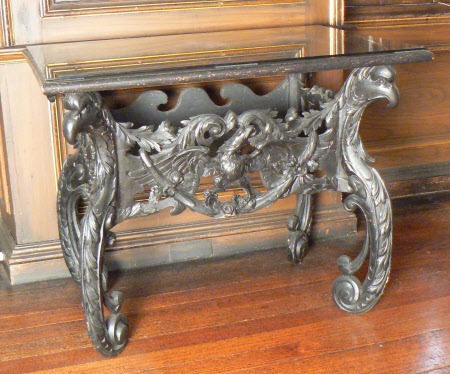Side table
Category
Furniture
Date
circa 1675
Materials
Ebonised beechwood, pine, fruitwood, veneer, canework
Measurements
85 x 101 x 70.5 cm
Place of origin
Holland
Order this imageCollection
Ham House, Surrey
NT 1140049
Summary
A side table, circa 1675, probably Dutch or French, the base of carved and ebonised softwood, the top with a central cane panel. Part of a set with candlestands 1139777.1 & .2. The top centred by a panel of cane within a painted veneered border. The base of four acanthus-carved legs formed as 'S'-scrolls, each terminating at the top in an eagle's head, and at the base in an inward-turning scroll. The legs joined at the front by a frieze centred by an eagle with outstretched wings perched atop a swag carved with clusters of flowers, beneath a pair of leafy scrolls. The sides with similarly-carved friezes. The rear frieze shaped but un-carved.
Full description
This table 'of black ebony cain’d', en suite with a pair of candlestands (NT 1139777.1 and NT 1139777.2.) and, originally, a 'greate looking glasse with an ebony frame caned', are listed as furnishing The Duke’s Dressing Room in the 1679 inventory of Ham House. The inventory taken two years earlier in 1677 is less precise, recording only a table and candle stands of 'ebony frame'. They were originally protected by leather covers. The design of these three pieces of furniture is French in origin - the scrolled feet of the candlestands relates to those in a drawing of c. 1680 by Nicodemus Tessin - but they may have been purchased for Ham House in Holland in 1672 when money was 'payed out for the Lady Dutchess of Lauderdale in Holland by Mistress V. der Huva', a transaction recorded in a document which also refers to 'a table and two gadons [gueridons, or candlestands]'. The idea of the triad of stands, a table and a mirror originated in France but was swiflty taken up across Europe. This table and stands - being ebonised and lined with cane - are particularly rare. One furniture historian has noted that the cane 'cannot have been especially practical and therefore probably reflects the fact that caning was highly fashionable at this time.'
Provenance
Listed in the Duke's Dressing Room in the Ham House's inventories of 1679, 1683 (possibly 1677). Acquired in 1948 by HM Government when Sir Lyonel, 4th Bt (1854 – 1952) and Sir Cecil Tollemache, 5th Bt (1886 – 1969) presented Ham House to the National Trust, and entrusted to the care of the Victoria & Albert Museum, until 1990, when returned to the care of the National Trust, and to which ownership was transferred in 2002.
References
Bowett 2002: Adam Bowett, English Furniture 1660-1714, 2002, p.126 Thornton and Tomlin 1980 Peter Thornton, and Maurice Tomlin. “The Furnishing and Decoration of Ham House.” Furniture History, The Journal of The Furniture History Society Vol.XVI, 1980, pp.50-51 Rowell 2013: Christopher Rowell (ed.), Ham House, 400 Years of Collecting and Patronage, Yale University Press, New Haven & London 2013, 131-2
